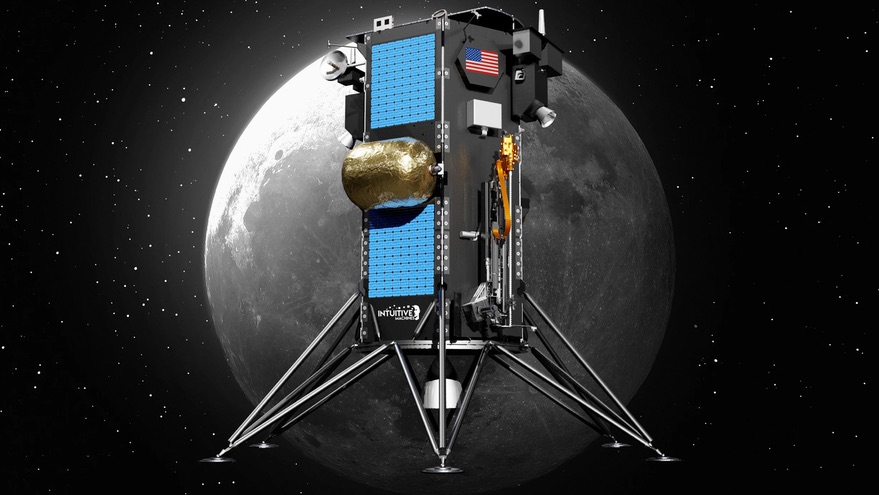WASHINGTON — The first lunar lander mission by Intuitive Machines, which had been scheduled for launch late this year, has been delayed to early 2022 by its launch provider, SpaceX.
Intuitive Machines had planned to launch its Nova-C lander on the IM-1 mission in the fourth quarter of this year on a SpaceX Falcon 9, carrying a combination of commercial and NASA payloads. A March 24 news release about an agreement to use the Parkes radio telescope in Australia as a ground station for the mission mentioned a launch “towards the end of 2021.”
However, in an April 23 application filed with the Federal Communications Commission to obtain S-band spectrum for the mission, Intuitive Machines said that the lander was now scheduled for launch in early 2022. The company didn’t provide a more specific launch date or a reason for the delay in its FCC filing.
Intuitive Machines spokesman Josh Marshall said April 26 that the slip was caused by its launch provider. “SpaceX informed Intuitive Machines that due to unique mission requirements the earliest available flight opportunity is in the first quarter of 2022,” he told SpaceNews.
Marshall referred questions about the “unique mission requirements” that caused the delay to SpaceX. That company did not respond to questions from SpaceNews on the topic.
The 1,908-kilogram Nova-C spacecraft will launch into a supersynchronous transfer orbit of 185 by 60,000 kilometers. Nineteen hours after launch it will carry out a translunar injection maneuver to go to the moon, performing another maneuver to enter a 100-kilometer lunar orbit. Nova-C will then attempt a landing at Mare Serenatis for a surface mission landing 14 days. Intuitive Machines said in the filing it will attempt to contact the solar-powered lander again after the 14-day lunar night, but acknowledged “is highly likely that the NOVA-C will not survive the lunar night.”
Intuitive Machines’ application with the FCC seeks to use the agency’s new streamlined processing for small satellites, even though the spacecraft weighs nearly four times the limit of 500 kilograms established by the FCC for using that process. A waiver of that mass limit, the company argues, “is appropriate and necessary in this case given extremely short-term use of the NOVA-C and the fact that it is non-Earth orbiting commercial lunar mission.” It added that it believed that it was in the public interest to waive the mass limit given the role of IM-1 in NASA’s overall Artemis lunar exploration program.
The company also seeks FCC permission to use S-band frequencies even though there is no commercial allocation for them. “Intuitive Machines is providing services on behalf of a government agency and is supported through Federal funding,” it noted in the filing, adding that it would coordinate with government users of that band to avoid interference.
The lander is carrying several payloads for NASA through the agency’s Commercial Lunar Payload Services (CLPS) program. Intuitive Machines received one of the first CLPS awards in May 2019, valued at $77 million for a mission then scheduled for launch in July 2021. Those payloads are a laser retroreflector, a lidar for navigation during landing, stereo camera system, an autonomous navigation experiment and low-frequency radio experiment.
IM-1 will also have several commercial payloads on the lander. They include a small rover from British company Spacebit, a camera that will be deployed to provide an external view of the landing, an astronomical telescope for the International Lunar Observatory Association, a radiation measurement sensor, a “passive data cache” in the form of etched metal disks and a sensor to measure propellant tank levels.
IM-1 was to be the first CLPS mission to launch, and one of two scheduled to fly this year. The other is Astrobotic’s Peregrine lander, which received a $79.5 million award from NASA at the same time Intuitive Machines won its first CLPS contract.
Astrobotic announced its latest customer for that mission April 22. The German space agency DLR will fly a radiation sensor on that spacecraft similar to those that will fly on the Artemis 1 Orion test flight. That release stated that the launch was still scheduled for 2021, although a DLR release said the mission would go to the moon “at the end of the year.”
Peregrine will be the payload for the first launch of United Launch Alliance’s new Vulcan Centaur rocket. ULA is targeting a first Vulcan launch late this year, but has not provided a more specific launch date.
